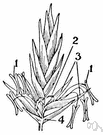fescue
Also found in: Thesaurus, Encyclopedia, Wikipedia.
fes·cue
(fĕs′kyo͞o)n.
1. Any of various perennial grasses of the genus Festuca, often cultivated as pasturage.
2. Any of several annual grasses of the genus Vulpia of dry habitats.
[Short for fescue grass (so called from its being grown for hay and straw), from Early Modern English fescue, straw, piece of straw, alteration of Middle English festu, straw, from Old French, from Late Latin festūcum, from Latin festūca; perhaps akin to ferula, giant fennel (which has hollow stems), and fistula, hollow stalk, pipe.]
American Heritage® Dictionary of the English Language, Fifth Edition. Copyright © 2016 by Houghton Mifflin Harcourt Publishing Company. Published by Houghton Mifflin Harcourt Publishing Company. All rights reserved.
fescue
(ˈfɛskjuː) orfescue grass
n
(Plants) any grass of the genus Festuca: widely cultivated as pasture and lawn grasses, having stiff narrow leaves. See also meadow fescue, sheep's fescue
[C14: from Old French festu, ultimately from Latin festūca stem, straw]
Collins English Dictionary – Complete and Unabridged, 12th Edition 2014 © HarperCollins Publishers 1991, 1994, 1998, 2000, 2003, 2006, 2007, 2009, 2011, 2014
fes•cue
(ˈfɛs kyu)n.
1. any grass of the genus Festuca, some species of which are cultivated for pasture or lawns.
2. a pointer used to point out the letters in teaching children to read.
[1350–1400; Middle English festu < Middle French « Latin]
Random House Kernerman Webster's College Dictionary, © 2010 K Dictionaries Ltd. Copyright 2005, 1997, 1991 by Random House, Inc. All rights reserved.
fescue
- A pointer, such as that used by a teacher, having originally meant "a straw or twig."See also related terms for teacher.
Farlex Trivia Dictionary. © 2012 Farlex, Inc. All rights reserved.
ThesaurusAntonymsRelated WordsSynonymsLegend:
Switch to new thesaurus
| Noun | 1. |  fescue - grass with wide flat leaves cultivated in Europe and America for permanent pasture and hay and for lawns fescue - grass with wide flat leaves cultivated in Europe and America for permanent pasture and hay and for lawnsgrass - narrow-leaved green herbage: grown as lawns; used as pasture for grazing animals; cut and dried as hay Festuca, genus Festuca - a genus of tufted perennial grasses of the family Gramineae |
Based on WordNet 3.0, Farlex clipart collection. © 2003-2012 Princeton University, Farlex Inc.